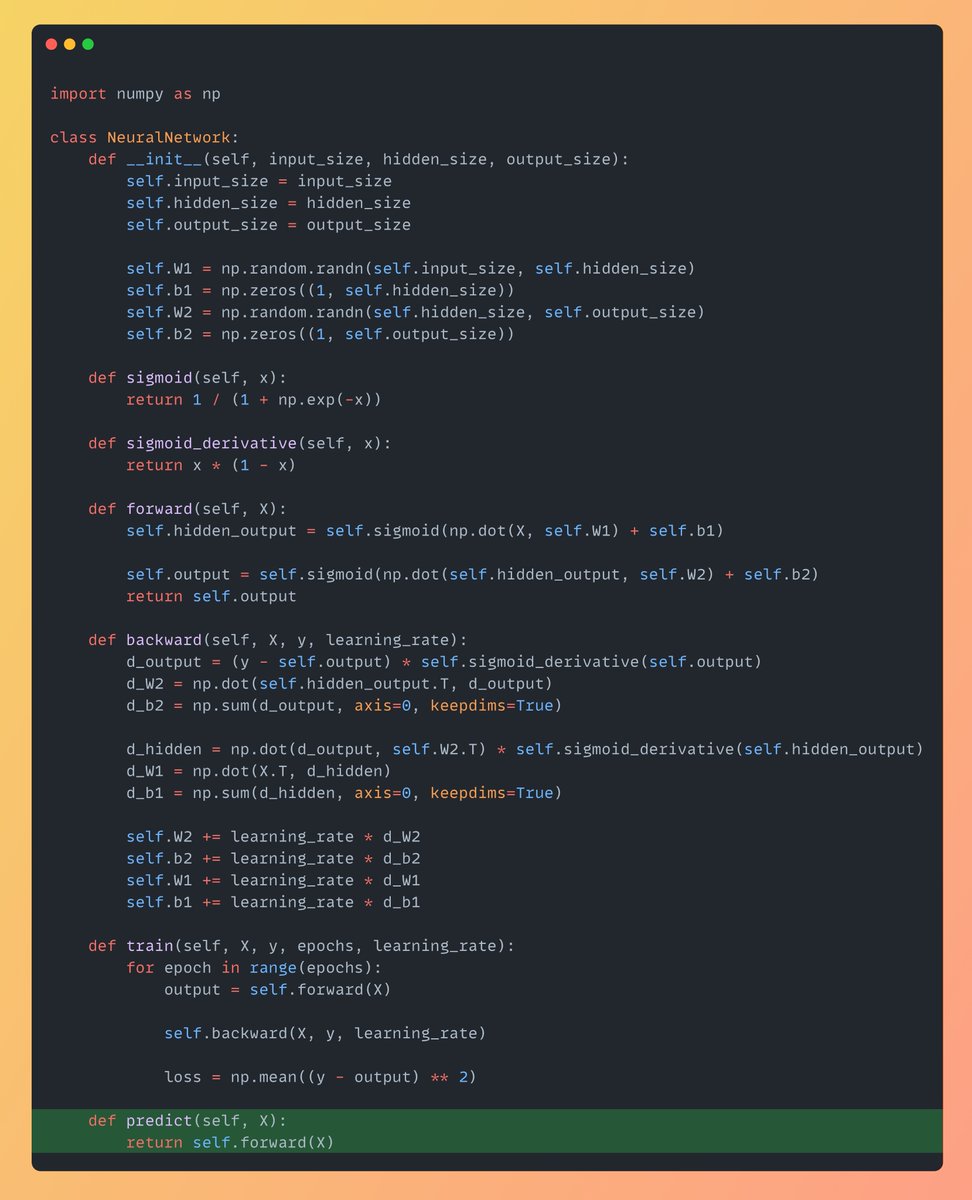Neural Network implemented from scratch in Python🔥
Here is the step by step explanation with code.
Thread🧵👇
Here is the step by step explanation with code.
Thread🧵👇

Below is the simple Neural Network consists of 2 layers:
- Hidden Layer
- Output Layer
First Initialize the size of layers along with the weights & biases.
And also define the sigmoid activation function & it's derivative which is really key to introduce non-linearity.
- Hidden Layer
- Output Layer
First Initialize the size of layers along with the weights & biases.
And also define the sigmoid activation function & it's derivative which is really key to introduce non-linearity.

Forward Pass:
Here the input data is passed through the neural network to obtain the predicted output.
In forward pass, First calculate the output of the hidden layer.
hidden_output = X•W1 + b1
Then apply the sigmoid activation to the output.
output = sigmoid( (X•W1) + b1)
Here the input data is passed through the neural network to obtain the predicted output.
In forward pass, First calculate the output of the hidden layer.
hidden_output = X•W1 + b1
Then apply the sigmoid activation to the output.
output = sigmoid( (X•W1) + b1)

Backward Pass:
First compute the gradients of the output layer.
Loss = (y - output)
Gradient of Loss = (y - output) * sigmoid_derivative(output)
Now calculate d_W2 which is gradient of the loss function with respect to W2.
d_W2 = hidden_output.T • Gradient of Loss
First compute the gradients of the output layer.
Loss = (y - output)
Gradient of Loss = (y - output) * sigmoid_derivative(output)
Now calculate d_W2 which is gradient of the loss function with respect to W2.
d_W2 = hidden_output.T • Gradient of Loss

Similarly calculate d_W1, d_b2 & d_b1
dW1: Gradient of the loss function wrt W1
d_b2: Gradient of the loss function wrt b2(bias of neuron in output layer)
d_b1: Gradient of the loss function wrt b1(bias of neuron in hidden layer)
dW1: Gradient of the loss function wrt W1
d_b2: Gradient of the loss function wrt b2(bias of neuron in output layer)
d_b1: Gradient of the loss function wrt b1(bias of neuron in hidden layer)

Now Update the Weights:
Here learning rate is the hyper parameter!
A low learning rate can cause the model getting caught in local optima, while the high learning rate can cause the model to overshoot the general solution
W1 += learning_rate * d_W1
b1 += learning_rate * d_b1
Here learning rate is the hyper parameter!
A low learning rate can cause the model getting caught in local optima, while the high learning rate can cause the model to overshoot the general solution
W1 += learning_rate * d_W1
b1 += learning_rate * d_b1

Now a method to train the neural network using both the forward and backward passes.
The function will run for specified no of epochs, calculating:
1. The Forward Pass
2. Backward Pass
3. Updating the Weights
The function will run for specified no of epochs, calculating:
1. The Forward Pass
2. Backward Pass
3. Updating the Weights

Finally the Predict Function
Now to predict on any new data all we need to do is a single Forward Pass through the Network:
Now to predict on any new data all we need to do is a single Forward Pass through the Network:

That's a wrap!
Every day, I share and simply content around Python, Data Science, Machine Learning & Large Language Models.
Find me → @Sumanth_077 ✅
Like/RT the first tweet and help this reach more people.
Every day, I share and simply content around Python, Data Science, Machine Learning & Large Language Models.
Find me → @Sumanth_077 ✅
Like/RT the first tweet and help this reach more people.
• • •
Missing some Tweet in this thread? You can try to
force a refresh





